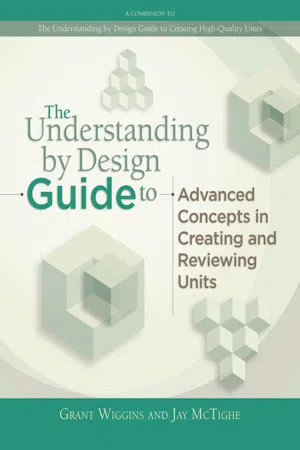
Understanding by Design Guide to Advanced Concepts in Creating and Reviewing Units
- 136 pages
- English
- PDF
- Available on iOS & Android
Understanding by Design Guide to Advanced Concepts in Creating and Reviewing Units
About This Book
The Understanding by Design Guide to Advanced Concepts in Creating and Reviewing Units offers instructional modules on how to refine units created using Understanding by Design (UbD) and how to effectively review the units using self-assessment and peer review, along with observation and supervision. The Guide builds upon its companion and predecessor, The Understanding by Design Guide to Creating High-Quality Units, and like the earlier volume, it presents the following components for each module:
* Narrative discussion of key ideas in the module
* Exercises, worksheets, and design tips
* Examples of unit designs
* Review criteria for self- and peer assessment
* References for further information
UbD is based on a backward design approach and is used by thousands of educators to create curriculum units and assessments that focus on developing students' understanding of essential ideas and helping students attain important skills. The Guide is intended for use by individuals or groups in K-16 education (teachers, school and district administrators, curriculum directors, graduate and undergraduate students in curriculum, and others) who want to further develop their skill in UbD. Users can work through the modules in order or pick and choose, depending on their interests and needs.
Additional resources, including worksheets, examples, and FAQs, are available as downloadable forms (including fillable UbD templates that can be saved electronically), making it easy for UbD practitioners to advance their understanding and their ability to create curriculum that leads to deep, meaningful learning.
Frequently asked questions
Information
Table of contents
- Cover
- Title Page
- Copyright
- Table of Contents
- List of Figures
- Introduction
- Module I: Unpacking Standards
- Module J: Identifying Evaluative Criteria for Assessments
- Module K: Refining the Learning Plan in Stage 3
- Module L: Sharpening Essential Questions and Understandings
- Module M: Authentic Assessment and Validity
- Module N: Differentiating—Tailoring the Learning Plan to the Learners
- Module O: Designing the Lesson Plan for Your Unit
- Module P: Obtaining and Using Feedback
- Conclusion
- About the Authors
- Related ASCD Resources: Understanding by Design
- Search this Book